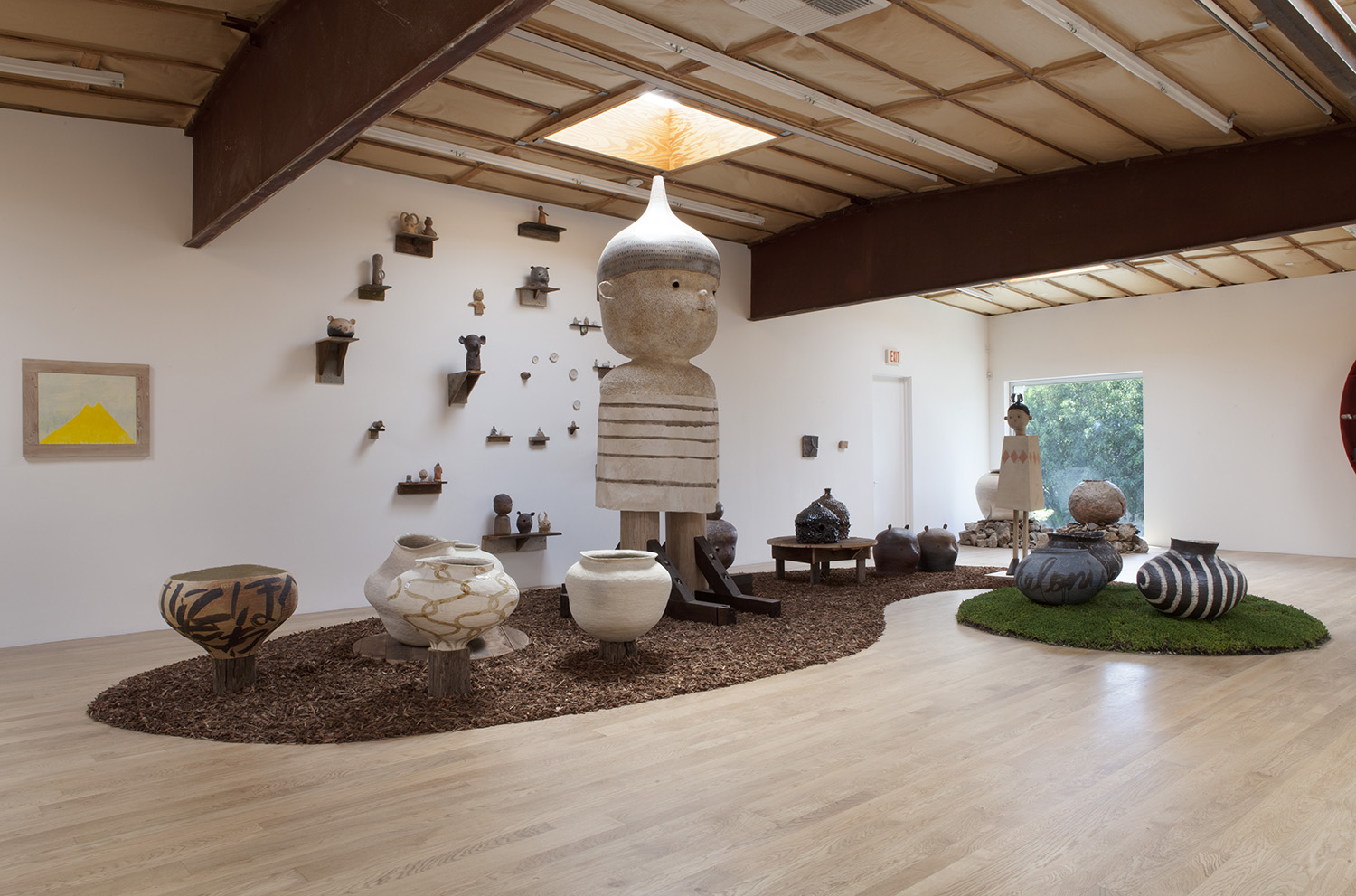Kazunori Hamana, Yuji Ueda, and Otani Workshop
Curated by Takashi Murakami
September 11 – October 24, 2015
Blum & Poe
2727 S. La Cienega Boulevard, Los Angeles, CA 90034
This exhibition, featuring ceramics by three contemporary Japanese artists, embodies in many ways the aesthetics of its curator, Takashi Murakami. Murakami’s notion of “super-flatness” is sketched out in many of the features worked in two-dimensional, simplistic, even child-like or primitive fashion on the faces of the more human-like figures. Also demonstrated is his blurring of traditional creative practices (the exhibition statement references at length the historic practice that ties Japanese ceramics to elaborate tea ceremony rituals) along with newer gestures and techniques hewn from more recent popular aesthetics such as manga and anime (e.g. the cartoony visages of these ceramicists’ sculptural figures). In the hands of others—and perhaps taken singly as existing objects—some of these gestures might appear as more mediocre, or even devolve to kitsch, but collectively this naturalistic installation gives additional life and dimensionality to the individual pieces as well as the larger overall population of works.

Kazunori Hamana, Yuji Ueda, and Otani Workshop. Installation view, 2015. Blum & Poe, Los Angeles
A prolific overflow of objects across an impressive range of type and scale—from the smallest finger-size nodule of a figure displayed in its own cubby niche to the looming, larger-than-human, humanoid figure of Otani Workshop’s Netherworld Resident (2015), in its dark cupola-shaped cap and crudely covering striped toga towel serape, this sumptuous array of work avoids feeling dense, creating a rarefied world through the smartly arranged and unprecious installation. Spread across a dozen or so stations—some free-standing or set within small heaps of natural materials on the floor; several laid out on or within custom-made wall-shelves—each individual piece and grouping establishes its own character, while deriving extra vitality through its relationship with the works surrounding it. With the exception of a few handfuls of each artist’s output congregated in relative insulation from the others’ work—isolated within some of the small islands set upon the floor, or ensconced in small archipelagos of wall-mounted shelves—the greater part of the work of the three artists is happily co-mingled. Informed perhaps by the rural contexts in which the three ceramicists work, several of these groupings have the feeling of anthropological displays or mock human settlements; they are presented as clustered gatherings, many of them in rustic contextualizing elements such as fragrant patches of sod, and loosely arrayed, shallow piles of rich soil or clusters of monochrome, broken, differing sized chunks of rock.

Kazunori Hamana, Yuji Ueda, and Otani Workshop. Installation view, 2015. Blum & Poe, Los Angeles
Even the most populous clusters and widest diversity of elements parked within the large, red-painted circular wall-mounted cubbies or the rough-hewn shelves made of driftwood and other rough timbers sidestep the crude theatrics of some modern-day curiosity cabinet emulations through the casual-seeming, careful display, through the natural lighting, and through the distinct sort of vitality most of the objects project. These objects include highly stylized and asymmetrical to utilitarian-seeming vases, urns and cups of all sizes to amulet-like bracelets and smaller talismanic oblong forms looking like barely worked-on found minerals. Many of the works in this setting have the sense of relics from some understudied ethnic group or groups. Occasionally they are decorated with Japanese kana and Roman alphabet, and more frequently, with abstract geometric patterns.
Kazunori Hamana’s sometimes rougher aesthetic peaks in an abstract set of four roughly carved, dark grey dolmen or stele-like columns, Untitled (2015), or more delicately in the seemingly breaking large eggshell of ceramics in another Untitled work from 2015, a motif of organic-seeming emerging from unevenly textured surfaces that is echoed in more than one of Yuji Ueda’s own untitled irregular, thick, orb-like vessels from 2012 through 2015, with varying degrees of flaking texture, brittle layers, and colors ranging from almost bright bone-white through a range of umbers to dark, smoky blue-greys, the signs of firing approaching the volcanic in appearance.

Kazunori Hamana, Yuji Ueda, and Otani Workshop. Installation view, 2015. Blum & Poe, Los Angeles
Meanwhile. among the more playful iconic figures are Otani Workshop’s White Bear (2015)—with its convincingly serious demeanor despite the cartoony rendering of its thick, off-white knobbly finish; the sweeter, more schematic Sister Bear (2015); and Otani’s Teletubby-like figure of Hydrant Person (2015), Not only these more animal-like creature-forms but even many of the more feature-less vessel pieces demonstrate an unusually anthropomorphic tendency—as is the case with the several vases and urns that peer out yearningly or uneasily through windows both towards the inner, lower space of the gallery, and separately towards the outside of the gallery’s back parking lot.
With their varying degrees of finish—from deliberately rough, irregular and at times fragile; to a fewer that are more polished and smooth, though mostly unglazed—the individual pieces have some of the aura of relics and idols from animistic displays of cosmological import. As a whole and in its individual works, the exhibit retains a subtle and remarkable sense of the uncanny. While they are of human form and crafting, the works also seem not obviously or entirely human by prior conventions, however much they appear to be fashioned after, and fashioned by, humans themselves.



